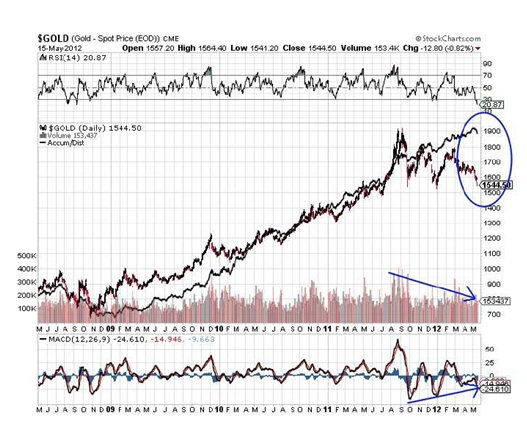Gold & Precious Metals
Paper gold & silver Ponzi exposed
Posted by Brett Heath via Peter Grandich
on Saturday, 19 May 2012 15:48
Anyone watching the gold and silver market understands that something is not right. An objective look at the fundamentals suggests that there seems to be no substance behind the recent downwards move.


Notorious Gold Bear Covers Shorts…can this be the sign of a bottom?
Posted by Victor Adair
on Friday, 18 May 2012 18:02

Victor Adair covers his Gold Shorts.

Gartman: Don’t Buy Gold – But Others Disagree
Posted by Dennis Gartman via Resource Investor
on Thursday, 17 May 2012 7:00
Trader, economist and Gartman Letter publisher Dennis Gartman knows when he is wading into a hostile crowd. He brought up gold in his keynote address to the New York Hard Assets Investment Conference this week and immediately acknowledged his contrarian views:
“What should money be doing?” he asked.“You’ll not like me for this. Don’t put it in gold. It’s not going up any more. It was a great trade for three years. It was a wonderful, ebullient, beautiful, marvelous trade for three years. Ain’t been so good now for the last year and a half. It sucks. There’s a really insightful economic perspective. It’s making new lows, doesn’t make new highs, keeps falling, everybody you know wants to buy some. It’s not a safe harbor. And I object when I hear people – they actually interviewed me on TV today and said, ‘Mr. Gartman, what do you think about gold? Is it a safe harbor?’ I said, ‘It never was.’ Safe harbors don’t move three and four and five and eight and 12 and 15 percent a year up and down. Safe harbors are safe. Gold ain’t safe. It’s a currency. It’s something you trade. Sometimes it goes up, sometimes it goes down. But to get married to it is ludicrous and is wrong. Don’t fall for that. Right now if you look at a chart of gold each low is lower. Each high is lower. It will continue – mark this down – until it stops. But right now anybody who‘s bought gold in the past 15 months feels horrid about it. Don’t buy gold.
Where should you go? Who are the beneficiaries in the modern world. It’s simple: English speaking currencies … Whether you like it or not, people are going to still tell you the United States dollar will cease to be the reserve currency of the world sometime in the future. Yes, it will – 150 years from now. I’ll be long dead. I don’t care, at that point. But who does the reserve currency status always inure to? Who is the reserve currency country through history? No question, always is the same thing: the dominant military power. Period. End of discussion. And we are, we are now, we shall be, and as far as the eye can see we will continue to be the dominant military power.”
Gartman departed after his keynote address to the conference without taking questions while wishing his audience “good luck” with their trading.
But his view came back later when analysts gathered for a “Bulls and Bears Debate” keynote panel.
“It was wonderful to see the anger, angst and depression through the room,” said panel moderator Rick Rule, founder of Global Resource Investments Inc, a unit of the Sprott Group. “I always enjoy a speaker who makes an impact on the audience, irrespective really of the nature that impact. So who of you wants to be the anti-Gartman. I know for sure who’s going to take the Gartman case, so I’ll ask him later but who would like to be the ant-Gartman, any of you?
Ian McAvity, editor of Deliberations on World Markets: … I’m as bullish as can be, in large part because I’m seeing such extraordinary negativity and I’m also seeing the speculation as having been wrung out of not only gold but also silver and the mining stocks …The only missing ingredient that we’ve had is what I call a diaper change moment in the S&P that lets the margin clerks butcher the stocks down to what I think will be the buying opportunity the likes of which we haven’t seen since the fourth quarter of 2008,
Rule: I have two questions for you. We’ve just been through our own mini diaper change moment. What would you say about the fact that we’ve experienced ours and they haven’t experienced theirs yet;
McAvity: By a diaper change moment I’m talking something on the order of a thousand point down day in the Dow. We haven’t seen anything like that volatility yet.and the only question in my mind is whether it’s originating from the potential evaporation of the euro or from somebody dropping some nasty stuff in Iran.
Rule: I take it then – before I turn Paul loose on you – that the part of the thesis that Mr. Gartman propounded which was in some fashion recovery is nigh is not something you have any particular truck with.
McAvity: Well the economic recovery only shows up in two data series I track. That’s the issuance of food stamps and the growth of the national debt. If you look at housing starts and unemployment there is no evidence that Joe Sixpack is experiencing a recovery.
….read page 2 HERE

- Gold stock investors have been experiencing a type of “2008 again” decline in the price of their gold stocks, yet many other assets have barely declined at all. The question on everyone’s minds is, “Will this pain end soon, or is it just the beginning of something much bigger?”
- Please click here now. There are some good reasons to believe the Dow could be making an important top. “Sell in May and go away” is a respected market adage that is based on seasonality, and it is in play now.
- Aggressive speculators likely have a lot of sell orders just below the 12,700 area. I’m more interested in buying the Dow if it falls than trying to guess if it is making a top. It may be simply consolidating for a move towards 14,000, but if it does fall hard, I want to start buying it very lightly.
- The Dow has risen almost seven thousand points from the 2008 lows near 6500,so I would not commit very much capital to a price sale of only one thousand points.
- The 12,200 price zone is very light support. Please click here now. You can see more substantial support near 11,200. Buying the Dow very lightly about every 1000 points down is prudent, but investing huge amounts of capital after a few thousand points of price weakness is definitely not a good idea.
- If the Dow starts a severe price decline, could that cause an acceleration of the decline in gold and gold stocks? Yes it could, and you need to be prepared for such an event.
- A lesson for gold stock investors who think a bottom is in can be had from the price action of natural gas recently. A lot of investors became interested in natural gas at about $6.
- Instead of bottoming, it went to $2, and investors who thought that such a decline could never happen found themselves in a fair amount of trouble.
- I bought all the way down, and if natural gas goes much lower, I’ll continue to accumulate it. Most investors allocated too much capital in price areas where they thought gas had to stop falling, so their cash reserves are now low or non-existent. Your buy orders should always be “smaller than you know is rational”. This is because the market itself is not rational.
- Let’s not see a repeat of that natural gas situation with gold stocks now. Many investors and analysts are sure that gold stocks must bottom soon. Perhaps, but are you prepared to deal with much lower prices if they don’t? Prepare now, rather than assume that much lower prices are impossible.
…..read points 11-24 HERE
Stewart Thomson
Graceland Updates
website: www.gracelandupdates.com
email for questions: stewart@gracelandupdates.com“>stewart@gracelandupdates.com
email to request the free reports: freereports@gracelandupdates.com“>freereports@gracelandupdates.com
| Tuesday May 15, 2012 Special Offer for 321Gold readers: Send an email to freereports@gracelandupdates.com“>freereports@gracelandupdates.com and I’ll send you my free “Hedge My Silver, Please!” report. Learn how to increase the size of your silver position while increasing your emotional happiness deep in the accumulation zone with professional hedging! |

Trotting the globe in his unrelenting quest for investing opportunities, Bob Moriarty had just completed a 21,000-mile travel-a-thon when he picked up the phone for this exclusive interview with The Gold Report. He liked a lot of what he saw, found plenty of bargains along the way and is willing to name names. Ever the contrarian, he is picking up stocks when everyone else is dumping them; he plans to cash in when the mass of sellers morphs into a mass of buyers and drives prices up.
COMPANIES MENTIONED: ABZU GOLD LTD. –ARGENTEX MINING CORPORATION – CANACO RESOURCES INC. – COMSTOCK MINING INC. –CORAZON GOLD CORP. – EVOLVING GOLD CORP. –GOLD STANDARD VENTURES CORP. – MAG SILVER CORP. – NETCO SILVER INC. – TEMBO GOLD CORP. – TRUECLAIM EXPLORATION INC.
The Gold Report: We’re hearing many people these days warning that it’s not a good time for investing in junior mining stocks. The TSX Venture Exchange has been experiencing some of its lowest volumes in six to nine months. What do you believe investors should do this summer?
Bob Moriarty: Anybody following my website for years will be familiar with me saying this: You can ignore technical analysis. You can ignore seasonality. You can ignore fundamentals. The only thing you can ever absolutely make money in is being a contrarian. Some very big names in the mining industry, including Rick Rule and Eric Sprott, have said, yes we’re in the bottom but it’ll be several months before you should invest. Where were they April 25 last year, when I said we’d reached the top in silver? For months afterward, the very best place to be was in cash. You have to look at what people say and when they say it. Very few people got it last year, but I clearly was one of them.
We are at a major bottom in gold and gold shares. The fact that some of the biggest names in the business are telling investors to bail out or keep their hands on their wallets if they’re tempted to buy is a buy signal. If you have a hundred people in a room and every single one of them was a bear, the next trade would be up because you would have run out of sellers. The fact that the volume is so low speaks volumes all by itself. There are no buyers—only sellers, and we’re about to run out of those. When that happens, the very next trade will be up.
It’s a chicken-and-egg situation. Which came first? In this situation, was it the bottom or the news? Everybody hears, “The Dow went up 200 points today because of xyz.” They try to connect news with action and it’s exactly the opposite. When gold and gold shares go up, they’ll say it’s because of Iran, or Israel, or Osama bin Laden or Ron Paul. It’s nonsense. It will go up because we’re running out of sellers. When you have no sellers, you only have buyers. It’s that simple. Too simple for most people to understand. But those who do will make a lot of money. Dawn follows the darkest hours.
TGR: But suppose the government announces quantitative easing (QE) 3, for instance, or some new European debt problems crop up. Wouldn’t such news prompt investors to buy junior gold and silver shares?
BM: Absolutely not. What you hear on the radio, read in newspapers and most of what you see on the web is not news. It’s propaganda. We have the equivalent of QE3 in Europe, something like $6.7 trillion, and gold, silver and equities have been going down. There’s no connection between news and action. We have been spring-loaded to believe that the news is important and it’s not. It’s meaningless. Six people control 95% of the news media and you’re being told what they want you to believe. That doesn’t mean it’s news.
TGR: So you have to divorce yourself from the news if you really want to be a contrarian in investing in mining stocks?
BM: Absolutely. Every time I call a silver or gold top and I’m perfectly correct, a hundred people immediately write to tell me how stupid I am in calling a top when in fact they’re always dead wrong. They never tell me a month later; they always tell me as soon as I say it. Well, I’ve called tops and bottoms correctly for 10 or 11 years now. To be able to do that, either I have to know something other people don’t or I have to be the guy doing the manipulation. And believe me, I’m not the guy doing the manipulation. All markets are manipulated and that makes manipulation as close to meaningless as you can get.
The mere fact that shares are hard to sell and there’s very low volume is a buy signal all by itself. If you want to make a fortune in the junior mining segment, buy when nobody wants to buy and sell when everybody wants to buy. If that were all you did, you’d make 100% a year. Juniors have a 200–400% range every year. Buy when things hit a new low, sell when they hit a new high and ignore all the “gurus.”
TGR: You talked about calling silver’s high last April, and you’ve again been looking at silver and gold assets around the world. Do you consider yourself more of a silver bull or a gold bull? Or neither?
BM: I’m an agnostic. As for what I look for, I don’t look for silver or gold or boron or natural gas. I look for opportunities. The Argentex Mining Corp. (ATX:TSX.V; AGXM:OTCBB) silver property we visited two weeks ago is a hell of an opportunity, and I said so.
TGR: That’s in the Santa Cruz Province in Argentina, which has been a hotbed of exploration activity over the last several years.
BM: Yes, I was actually down there visiting four years ago. I liked the stock when it was $1.34/share. It’s trading at about $0.38/share now, but two weeks ago it was trading at $0.25/share. If you’re buying shares in silver at $0.25, you’re effectively buying silver equivalent at $0.11/oz. If silver goes down to $15/oz, you’re still going to make money.
Argentex will release a new NI 43-101 any day now, and they’ve doubled the amount of drilling, so it wouldn’t surprise me to see the resource almost double. But in any case, when silver was selling for $5/oz, there were silver company shares selling for $1/oz in the ground. So, $0.08, $0.11 or $0.20—that’s pretty cheap for an ounce of silver.
TGR: Do you look at certain jurisdictions or provinces that are particularly good for mining activity and then bet on some of those areas? Or is it always company specific in your view?
BM: It’s actually management-specific. You need to look at a lot of factors, of course, but the most important is management. The country or province is absolutely important. I’m going to write an article shortly and will call it “The Miners’ Lament.” It’s about having a gold or silver or boron project and the price of the commodity goes up. As soon as the price goes up, governments get greedy. That’s happened in Peru, Bolivia, Ecuador and Australia. To a certain degree it’s happening in Argentina, because the government has started getting greedy and claiming a bigger piece of the miners’ pie.
TGR: On May 4, Argentina’s Congress passed a bill to nationalize Repsol YPF SA (REP:BMAD), the biggest oil company there, expropriating 51% of Repsol’s shares. Although not entirely unexpected because President Cristina Kirchner had announced her decision to nationalize YPF a couple of weeks earlier, the action—pretty much effective immediately—sent shockwaves through the resource investing community. Do you think this news makes investing in Argentinian juniors more risky?
BM: There are a couple of different issues to address here. One is the stupidity of government in Argentina. In 1914, Argentina had the third-highest GDP in the world. Based on agriculture and metal wealth and the educational level of its people, Argentina still should be one of the wealthiest countries in the world. It’s not, and hasn’t been for 100 years now. The reason is 100 years of incredible stupidity in government.
The resources are there. The people are there. The climate’s wonderful. The wine’s good. Buenos Aires is a lovely city to live in. Yet Argentineans suffer economically. For the government to seize YPF is especially stupid. The excuse was it was not making enough money out of it—in much the same way that the power company in South Africa wasn’t making a profit because the government imposed limits on what the power company could charge for the power it sold.
Governments believe they’re smarter than the economy and they can repeal or modify the laws of supply and demand. They can’t. The last 6,293 times governments have tried to show they’re smarter than the economy, they’ve screwed it up. Governments just get in the way of people making money. If you go to Switzerland, you don’t even see government. In Sweden, government’s in the background and that’s a welfare state. But, government doesn’t figure into every newspaper article and everything you hear on the radio. In China, I don’t have a clue how the government works; I just know it’s an exciting place to make money.
So let’s go back to whether it’s safe to invest in Argentine juniors. I think it is because the juniors are in the exploration stage and they’re bringing money into the country. It would be especially stupid for the government to get involved at this point. I don’t think it will fool around with the production companies yet, either, but there’s no limit to the stupidity of governments.
TGR: Santa Cruz Province in particular seems to be a fantastic jurisdiction for exploration—great roads, nearby power, supportive locals. I was impressed.
BM: I was quite impressed too. And I know that you went to see another project. I saw Netco Silver Inc. (NEI:TSX.V; NTCEF:OTCBB), which is on the Chilean border. It has a similar series of sheeted veins and high silver grades. The company has been totally ignored by the market.
TGR: Tell us a little bit more about Netco.
BM: When I look at a property, I try to figure out the limits. I saw a series of sheeted veins, similar to what we saw in Santa Cruz at Argentex. I think Netco found 10, 12 or 15 kilometers in strike length. Netco has two problems. First, it’s one of the most god-awful names I’ve ever heard and, second, the management hasn’t done or said anything for five years, so the market has totally ignored it. However, that’s exactly what I look for—opportunity.
Every project I’m going to see now has low-hanging fruit just begging for somebody to come along and pluck it, take it home and eat it. How can you beat silver at $0.11/oz? Netco has 2,000–3,000 gram silver intercepts over meters and nobody’s ever heard of them before, including me.
There are so many companies out there now that you could invest in the biggest piece of crap stock in the universe and it will be up 100% or 200% in a year. Really good stories, from Argentex and Netco in Argentina to Tembo Gold Corp. (TEM:TSX.V), Canaco Resources Inc. (CAN:TSX.V), Kinross Gold Corp. (K:TSX; KGC:NYSE) and Keegan Resources Inc. (KGN:TSX/NYSE.A) in Africa—you could name 100 companies and they’re going to be up 400% to 500% in the next 18 months.
TGR: Well, Bob, let’s go off and harvest some of that low-hanging fruit. You travel the world. Tell us about some of your favorites.
BM: One of the real low-hanging fruits has to be Canaco, which went from an $800 million (M) market cap a year ago to about $80M or $100M now. The stock has gone from $8/share down to $0.88/share and the company has only about $0.60/share in cash. But it’s worth $800M. Its intercepts are fabulous. No question whatsoever, it’s going to be a mine. It has no particular issues.
Tembo did a financing at $1/share last year, made its initial public offering in February, and its stock went up to $2.20 or $2.30/share shortly afterward. I think it’s trading at close to $0.90 now. Tembo’s project in Tanzania is located right next to Barrick Gold Corp.’s (ABX:TSX; ABX:NYSE) Bulyanhulu gold mine, and the same team that ran Bulyanhulu is now at Tembo. They’re coming up with intercept after intercept and know exactly what they have. With a 97,000-meter drill program scheduled, Tembo’s going to have millions of ounces. And the company’s being given away.
TGR: How do you view Tanzania in terms of jurisdictional risks?
BM: The real issue there is the infrastructure. Mining provides most of the country’s export income, so it’s as important in Tanzania as it is in Peru. If you want to talk about jurisdictional risk, look at Peru and think again about “The Miners’ Lament.” Newmont Mining Corp. (NEM:NYSE) is trying to build a $4.8 billion mine in Cajamarca Province. The president of Cajamarca Province is demanding a $780M slush fund that only he has access to for “environmental” purposes. I can guarantee it’s a bribe and he wants 1.5% of the purchase price to let Newmont get into business.
Peru’s smart enough. It gets 60% of its export earnings from mining and now has a process in place whereby some of these idiots can be thrown out, and I think the local people in Cajamarca are about to throw him out. There’s so much corruption in Peru. It’s like Ecuador and Bolivia—there’s no rule of law.
North of there, Corazon Gold Corp. (CGW:TSX.V) operates in Nicaragua. Its stock is going for one-third of the price from two months ago, and I’m picking up some for myself. Corazon was smart enough to walk away from the Santo Domingo concession in central Nicaragua because the terms weren’t very attractive. But just a few weeks ago, the company picked up three excellent new properties, contiguous concessions along the Rio Coco in northern Nicaragua.
TGR: Going back to Africa for a moment, are there any other names you like there?
BM: Abzu Gold Ltd. (ABS:TSX.V; ABZUF:OTCQX) has some world-class projects in Ghana and absolutely fabulous management. In fact, it shares management with MAG Silver Corp. (MAG:TSX; MVG:NYSE), which is one of the big success stories of the last 10 years. I’ve not visited Abzu, but I’ve been to the adjacent mining property. And getting back to your earlier question, from geological and jurisdictional points of view, both Ghana and Tanzania are excellent places to work.
TGR: What are some of the North American stories you like, Bob?
BM: First, let’s talk about the difference between Canada and the United States. Canada is a wonderful place to work. I think it’s the most favorable mining community in the world. There’s some invisible line you cross when you go from the U.S. into Canada and all of a sudden, you become sane. The people in the U.S. amaze me with their ignorance of politics, economics and everything that’s going on in the world. They’re so insular; they just don’t pay attention.
Canada, on the other hand, is still an international country. The miners and geologists in Canada travel all over the world, and like Johnny Appleseed, they’re spreading goodwill and knowledge wherever they go. There is no mining anywhere in the world without an abundance of Canadians, and by the same token, no mining area anywhere else in the world has an abundance of Americans except America.
That said, from a geological point of view, there’s enormous opportunity in the United States, but the government’s still being especially stupid. At some point, somebody will realize you can’t keep spending more money than you take in. The United States is borrowing $0.41 out of every $1 it spends today. That’s insane. Some 88 million Americans are unemployed or underemployed—88 million people who aren’t working and we have only 64% employment among those who should be working. At some point, Americans will have to produce something besides hamburgers and new regulations and idiots in politics.
TGR: How does that relate to getting projects in Nevada, Montana and Arizona permitted and into production?
BM: It’s going to get easier. I went to see Trueclaim Exploration Inc. (TRM:TSX.V; TRMNF:OTCQX) in Arizona. Silver nuggets, which are extremely rare, were supposedly found on its property, and the whole story about the Lone Ranger firing silver bullets apparently came from there. It’s a perfect example of a wonderful project in a wonderful area. Arizona was settled because of mining in the first place. But the property is unfortunately on U.S. Forest Service land, which means jumping through 67 hoops and stumbling through a bureaucratic minefield to get anything done. That has to change.
TGR: Let’s get back to some of the other names you like.
BM: I like Comstock Mining Inc. (LODE:NYSE.A). I was visiting its properties in Nevada about a year and a half ago. Of course, it has the Comstock Lode, enormously rich in both gold and silver, and a lot of money in the till. But Comstock isn’t moving as fast as I’d like; I’d like to see things speed up there.
Evolving Gold Corp. (EVG:TSX; EVOGF:OTCQX; EV7:FSE) is really an interesting story. It has a joint venture on its Rattlesnake Hills project in Wyoming with a subsidiary of Agnico-Eagle Mines Ltd. (AEM:TSX; AEM:NYSE), which has agreed to spend $75M to earn half the project. So if half of Rattlesnake is worth $75M, the other half owned by Evolving Gold should also be worth $75M. But you can buy the whole company including its Carlin properties for $29M. Go figure. I visited its Carlin project in December. I think it’s very close to a major intersection where it has been drilling in the Carlin Trend.
I visited Gold Standard Ventures Corp. (GV:TSX.V; GDVXF:OTCQX) on the same trip, right next door to Evolving Gold. I said in December that Gold Standard may have already drilled a home-run hole on a major new deposit and not even realized it. In fact, that was the case, and its stock has gone from $1/share to about $2.50/share. Evolving Gold, on the other hand, is in the $0.22/share neighborhood, so cheap it’s insane. It was as low as $0.15/share in 2008, but up to a couple of bucks in 2009–2010.
TGR: To have new discoveries cropping up in Nevada is pretty exciting when you consider how much exploration has been done there. It’s amazing what Nevada is producing in terms of mining opportunity and wealth.
BM: I’m extremely familiar with the Carlin Trend and what’s been going on there in the last five years, and it’s the juniors who are making the bigger discoveries. I don’t even bother talking to the majors. They aren’t developing as many ounces as they’re producing, and they’re all going to be out of business in 10 or 15 years. You just can’t conduct your business doing it that way. But with someone like Gold Standard’s Vice President of Exploration Dave Mathewson doing the exploration, the juniors are coming up with these multimillion-ounce deposits that nobody dreamed of because they never tried drilling there before.
TGR: Obviously, you feel like it’s a shopper’s paradise in junior stocks. Are there any other opportunities that you’re particularly keen on that you’d like to talk about?
BM: Anything related to energy is an opportunity. Natural gas is being given away. And, from a contrarian point of view, it’s a gimmie. Potash is absolutely a big opportunity and graphite is another one.
TGR: So you don’t think all the buzz about graphite means it’s a bubble, a flavor of the month?
BM: It absolutely is the flavor of the month. But you get a bubble when about 450 companies are in a space, and now there are only about 30. I don’t expect all 30 to succeed, but I own about five of them. I’m quite happy to because I think there’s a wonderful opportunity there. When it gets to 450 companies, I’ll probably start selling some of my shares. Every investor should be familiar with Hobson’s Choice.
TGR: How so?
BM: Hobson was an innkeeper in rural England back in the 1700s. He was very lazy. If someone came to him asking for a trotting horse to ride around the village for an hour or two, he’d fetch the first horse nearest to the door of the stable. It might be a plow horse. So Hobson’s Choice was no choice at all or the best of a bad lot.
We live in a financial environment in which every bank in the United States has been bankrupt for four years and everybody is still pretending they’re going to survive. In Spain, 52% of the young people are unemployed. We are so close to a global revolution, it terrifies me. In that situation, you have to go to safety. So investors have no choice, really. And believe it or not, I don’t see anything safer than juniors—gold or graphite or boron or natural gas or potash. If you are faced with a choice of investing in U.S. T-Bills or Greek bonds or Spanish bonds or resource juniors, what would you invest in?
TGR: People always have to eat and need a way to trade.
BM: You’ve got it. But they must have something of value to trade. I don’t know whether the gold price will be $500/oz or $5,000/oz or $50,000/oz, but I can tell you that in two, three or five years, if you have a 10-ounce bar of silver in one hand and a 1-ounce gold coin in the other, you’ll know you’re holding something of value. Marc Faber says everybody should buy a $1M T-bill, put it in a nice frame, hang it on the wall and in 10 or 20 years when the grandkids visit, they can point to it and say, “See that? That used to be money.” Paper money is already a relic. It’s not a prediction—it’s here now. [Faber, who produces a monthly investment newsletter, Gloom Boom & Doom Report, chatted recently with The Gold Report.—Editor.]
TGR: You’ve given us some good stuff to chew on, Bob. Thanks so much for your time.
Convinced that gold and silver were at their bottoms, and wanting to give others a foundation for investing in resource stocks, Bob and Barb Moriarty brought 321gold.com to the Internet 11 years ago, and later added 321energy.com to cover oil, natural gas, gasoline, coal, solar, wind and nuclear energy. Both sites feature articles, editorial opinions, pricing figures and updates on the current events affecting both sectors. Before his Internet career, Moriarty was a Marine F-4B pilot and O-1C/G forward air controller with more than 820 missions in Vietnam. A captain at age 22, he was the youngest naval aviator in Vietnam and one of the war’s most highly decorated. He holds 14 international aviation records, and once flew an airplane through the Eiffel Tower’s pillars “just for fun.”
Want to read more exclusive Gold Report interviews like this? Sign up for our free e-newsletter, and you’ll learn when new articles have been published. To see a list of recent interviews with industry analysts and commentators, visit our Exclusive Interviews page.


-
I know Mike is a very solid investor and respect his opinions very much. So if he says pay attention to this or that - I will.
~ Dale G.
-
I've started managing my own investments so view Michael's site as a one-stop shop from which to get information and perspectives.
~ Dave E.
-
Michael offers easy reading, honest, common sense information that anyone can use in a practical manner.
~ der_al.
-
A sane voice in a scrambled investment world.
~ Ed R.
Inside Edge Pro Contributors

Greg Weldon

Josef Schachter

Tyler Bollhorn

Ryan Irvine

Paul Beattie

Martin Straith

Patrick Ceresna

Mark Leibovit

James Thorne

Victor Adair

